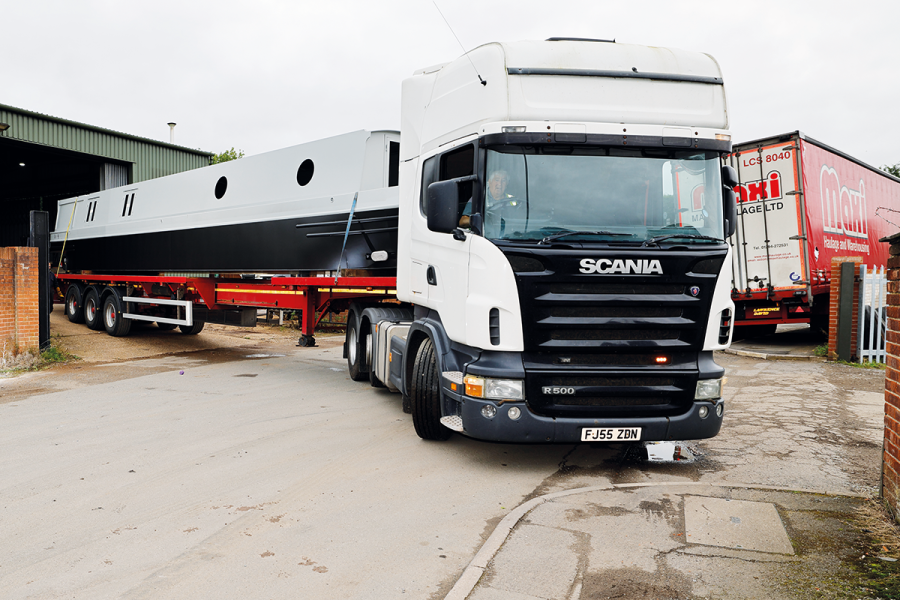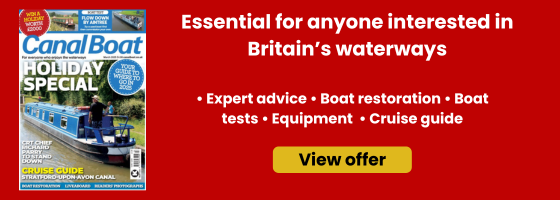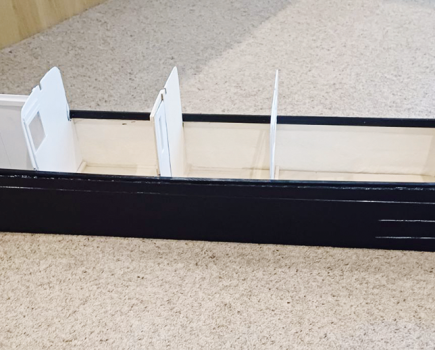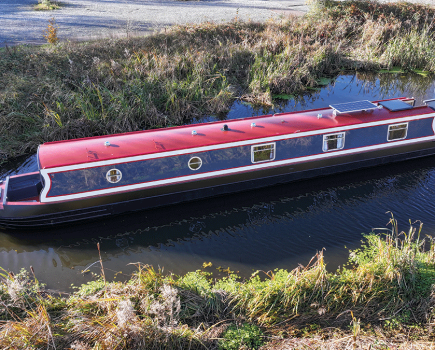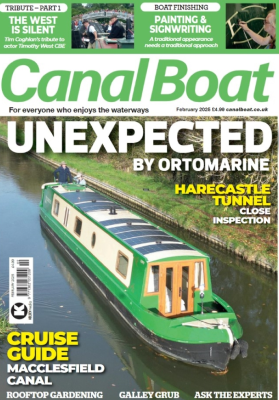As navigating a boat to where it’s needed isn’t always an option, road transport of canal boats is a given, but requires expert hands, as Ian Shaw finds out
Richard Dempster has 40 years of experience behind him and his company – along with his son Kevin – R&J Dempster & Son has shifted an estimated 5,000 canal boats in that time. Using two Scania artic trucks with extending frame Dennison trailers known as ‘Trombones’ the pair are a familiar sight around marinas and boatyards in the UK transporting new and second-hand boats for builders and private owners. Having met both Richard and son Kevin on numerous occasions on our respective travels it seemed time to give Canal Boat readers an insight into this specialist transport sector, without which few boats could move from builder to owner.
Richard’s Scania (with white cab) has some 500bhp from its straight-six turbocharged diesel engine – son Kevin’s silver truck has 440bhp from the same 13-litre unit and both have 12-speed automated transmissions, three axles and gross weights of 44 tonnes. In truck engines torque is much more important than horsepower and both trucks boast over 2300 Nm, at just 1,000 to 1,300 rpm.
Show boat
Once perched up on the trailer – literally a fish out of water – the narrowboat itself looks like a recipe for instability but in truth with steel hull and major masses under the waterline, the centre of gravity is thankfully low. This green and black one is from Bickerstaffe boats in Lancashire, at 57ft 6in long it weighs in at around 18 tonnes. “The majority used to be 57 feet,” says Kevin “Then we seemed to have a period of 62 footers and now it has returned to 57 foot again,” he adds.
Kevin’s Dennison Trombone trailer can extend to handle boats up to 70 feet, father Richard usually runs with the 65 footer. Although running on six axles, payloads are usually 17 to 18 tonnes. “Eighteen is usually the most, but we have seen some with electric motors and batteries up nearer to 20 tonnes,” says Kevin. Not that it will bother the big bright orange five-axle Liebherr crane seen here at the Crick Show in 2023. Kevin is happy with the load and its stability. He should be, since his father started the company 40 years ago RJ Dempster & Son has shifted an estimated 5,000 canal boats and the company is very familiar with the off-loading conditions at this venue.
He is perfectly familiar with the Scania too. It’s a brand the company has stuck with for years, to the extent that his business card carries a picture of a 1983 112M two-axle tractor with extending tri-axle trailer in the firm’s older red livery. Kevin’s Scania R440 6×2 mid-lift – the second axle lifting to save tyre wear with lighter loads – is ideal for this work and in addition to the two Dennison Trombone trailers, the company has a standard 40-foot curtainsider for general work now and then in between the boat haulage. The 13-litre straight-six is the blue-collar hero of the R-Series model range and successfully walks the fine line between having enough power to hold 56mph all day up hill and down dale and offering good operating economy. It is teamed with the two-pedal automated Opticruise gearbox in 12 ratio format and once the boat is lifted, the ratio choice comes down to finding traction on the loose surface of Crick’s slipway. “It’s not bad,” says Kevin, “But being automatic it can be a bit difficult to feed in the torque gradually, the hill start assist can grab a little too,” he feels. As it is there’s a hint of wheel spin but the R440 pulls away at idle, now unladen.
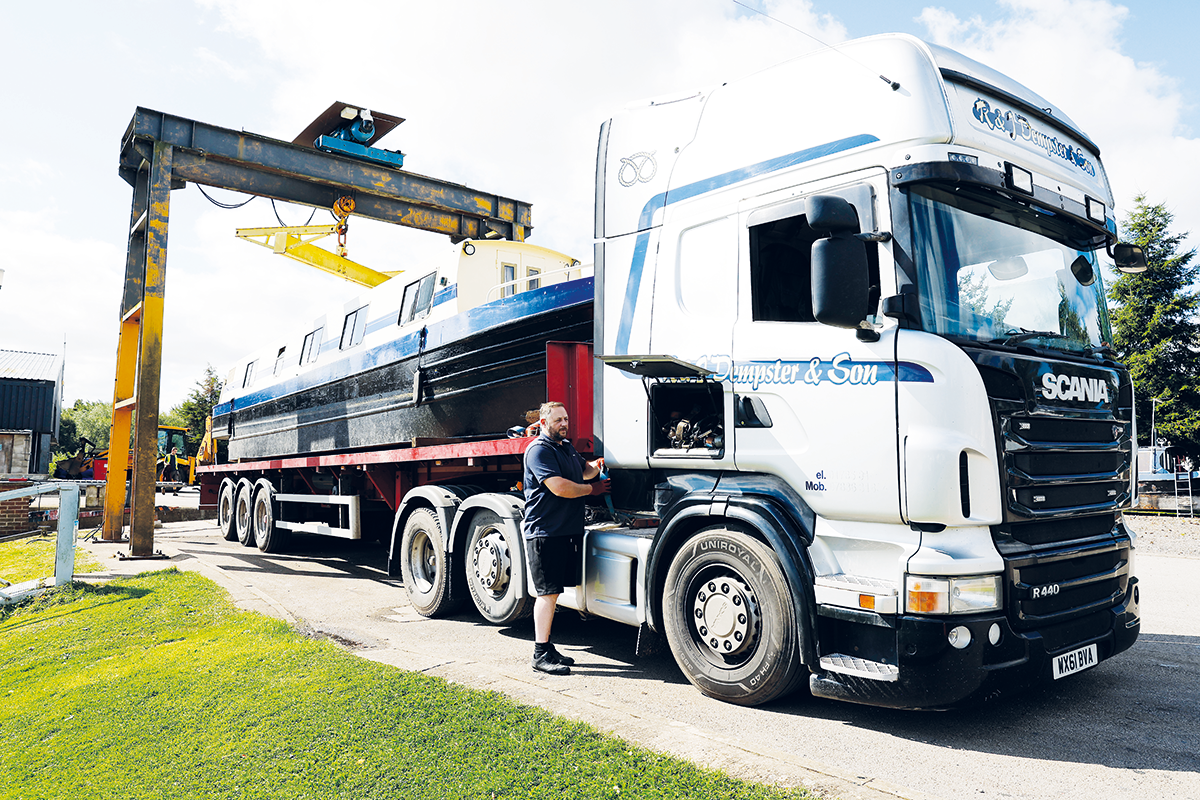
A fixed lifting gantry at Shardlow Marina takes the strain.
Stable platform, safe hands
The specialist nature of canal boat haulage is not immediately apparent, other than the obvious length, at up to 70 feet long, and although the steel shell might look as tough as a tank, they can be twisted with poor handling.
“There is a big issue with trailers for this work and there isn’t one easy answer,” says Kevin. Due to the length, some marinas will only allow rear-steer trailers on site, this blanket policy often causing issues in itself. “It’s certainly the case at some locations, the space can be restrictive so I can see why they come up with the idea,” admits Kevin, although rear-steer trailers can bring their own issues. At 50 to 70 foot, a lot of extending bed rear steer trailers are low loaders and although this works fine for a large excavator for example, it’s not so good for a narrowboat. “You can have a taller ‘cradle’ for the boat at the rear and rest the bow on the trailer’s swan-neck, but there can be quite a bit of flexing across the whole length,” explains Kevin. “I’ve seen granite worktops in the galley crack from end to end,” he adds. Not a cheap fix!
There are other issues with low loaders on this work too. “It might sound obvious to say, but where you have canals you have bridges and they are very often hump-back bridges. “There is one particular marina that you have to approach the long way round, even with a straight-extending trailer,” Kevin tells us.
Only a few weeks ago, a haulier slavishly following his SatNav, had grounded a low loader with narrowboat on the bridge. Fortunately, by slowly creeping over it (in hope) it was not stuck fast and a local farmer and his trusty tractor spared his embarrassment or further damage. Kevin’s knowledge of how to handle these loads is not learned from the outside, since he actually used to work as a narrowboat builder himself. “It gives me the knowledge of how to handle and secure them, and I’m proud to say that dad has always had a reputation for being careful, we get a lot of repeat business,” Kevin says. About two-thirds of the company’s work is for boat builders, the rest for private individuals wanting new boats collected, the old one traded-in or their boat moved to a different part of the country.
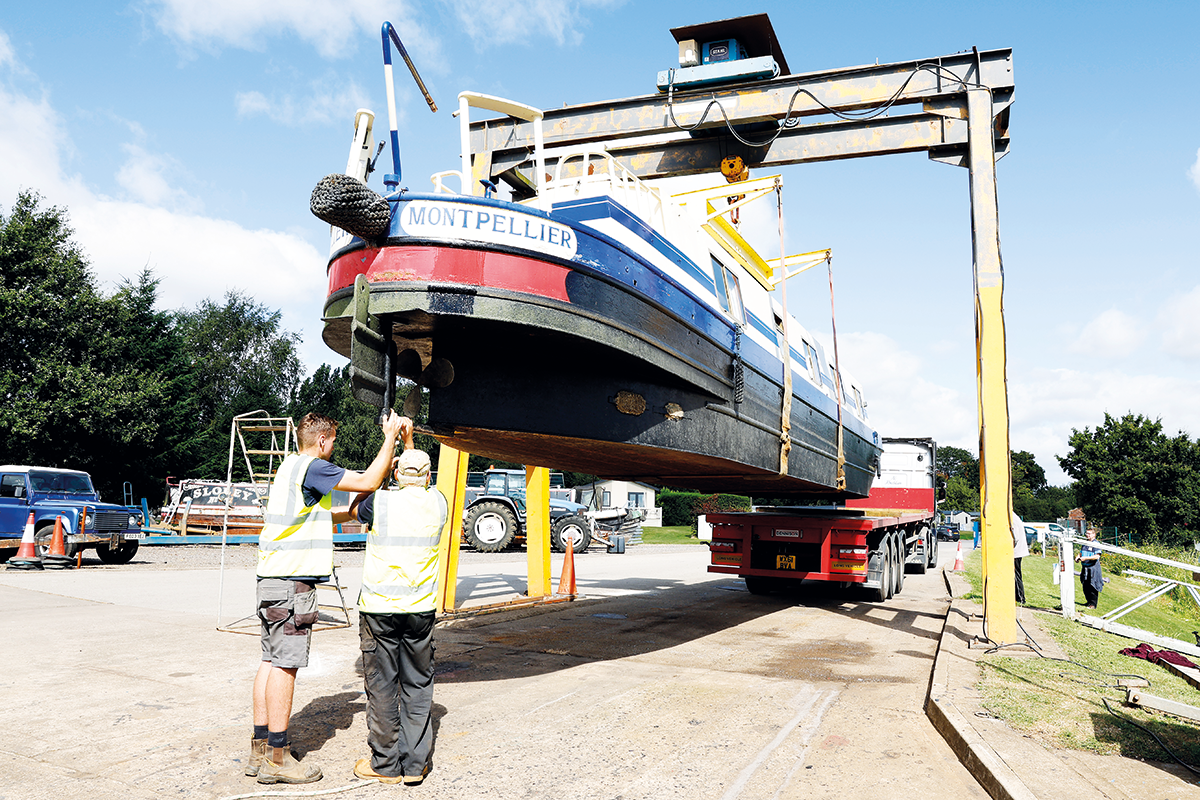
Shardlow’s skilled crew affect the perfect lift and Kevin pulls the truck away.
That’s the story with Kevin’s trip to Shardlow Marina shown here. The 50-foot Montpellier has just been acquired by Jamie Kerry and although Shardlow is not its home mooring this is the nearest point he can get this – his first narrowboat – into the water. Rather than a crane-lift into the water Shardlow Marina has two slipways it can utilise, depending upon the size of the boat and uses a submersible trailer and articulated four-wheel drive dumper as the tractor to affect this procedure. Kevin positions his trailer beneath the lifting gantry, the boat is lifted just clear of the 45-foot flatbed’s timbers, the Scania withdraws to the car park and Shardlow’s launcher is reversed under the Montpellier for the next stage of its journey.
Sounds simple enough and the skilled crew at Shardlow certainly make it look simple – the driver’s dexterity with articulated dumper and pivoting-drawbar trailer is a joy to watch – but as ever it’s the details which count. To the casual observer the boat looks level at first lift but the crew are not satisfied and painstakingly move the lifting straps a couple of times before being happy with it. Everyone instinctively knows what to do. Think, of a Formula One pit crew, taking their time. With the owner and assistant onboard an engine start-up and check of all systems sees the 50-footer reversed down the slip way and slowly easing off the trailer to float away astern, under its own power.
Boat transfers to new owners is big part of the Dempster’s work.
“We might see the same boat four or five times as it changes owners and likewise the same customer will keep coming back to us over many years. We can organise the crane and all the arrangements too and we’ll work with a number of crane operators who, by the same token, we know are good at this,” concludes Kevin. For now it’s time for Kevin to return to the yard and set-up for tomorrow’s job, shifting the first of a collection of some 30 ex-RAF trainer aircraft, bought by a private collector! Dull it isn’t.
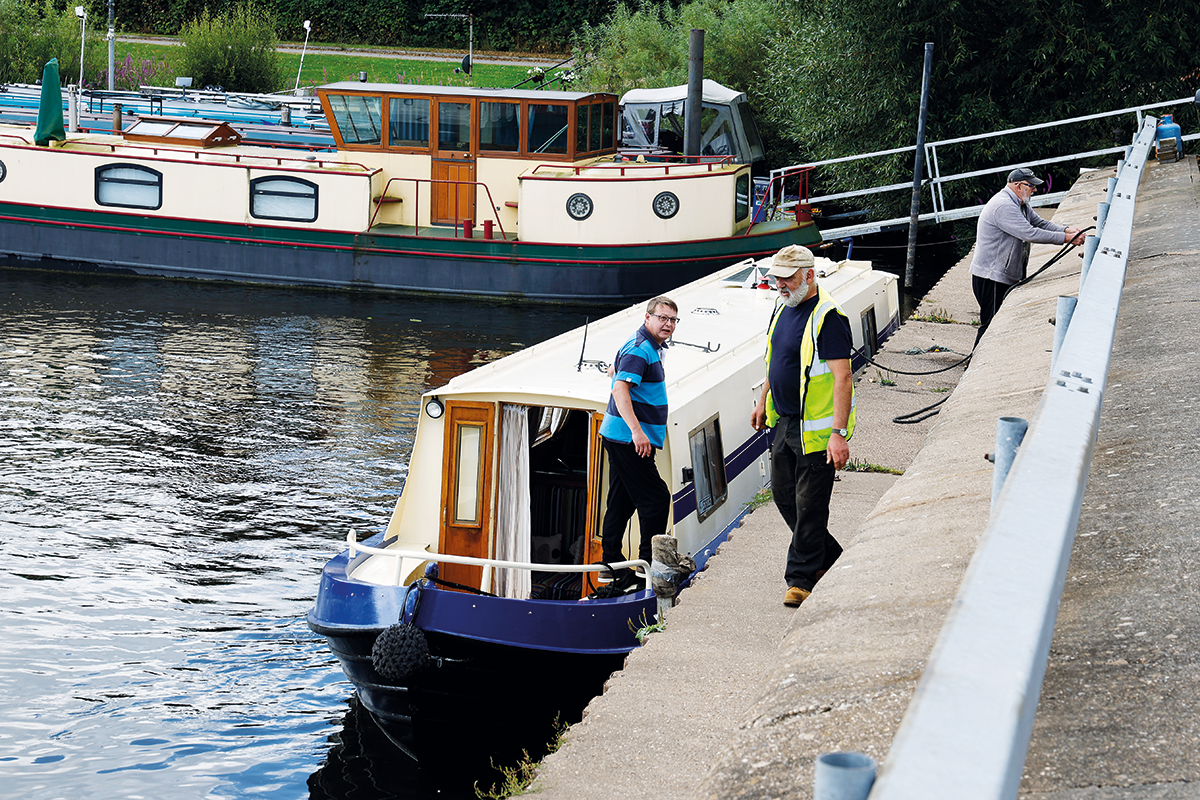
New owner Jamie Kerry (in blue shirt) moors-up for the first time
The author wishes to thank Richard and Kevin Dempster, all the staff and waterside crew at Shardlow Marina and Crick Marina and Montpellier’s owner Mr. Jamie Kerry for their assistance.
Trombone player
Celebrating over 50 years in the industry and still managed day-to-day by the founding Dennison family, Dennison Trailers is a leading manufacturer in both the UK and Ireland dominating the container transport sector in the main. In Ireland, Dennison is the market leader in the supply of tipping trailers and in the UK, it dominates the skeletal trailer sector too. RJ Dempster & Son however make good use of the company’s straight extending platform trailers, known as trombone trailers. The ability to accept long loads that would not fit onto a standard platform trailer but with otherwise similar qualities, make this trailer design ideal for construction and machinery hauliers and the go-to design for the niche of narrowboat transport.
These extendable trailers, capable of lengthening up to 21.25 metres (70 feet) are therefore capable of carrying the longest narrowboats without overhang. Although available as straight frame or drop frame versions, it is the straight frame design which is favoured in this sector, where the construction and earth-moving machinery haulier would more likely prefer the stepframe and its associated greater margins in load heights.
Dennison’s straight frame extendable Trombone trailer comes complete with a 29mm thick Keruing hardwood floor as standard. Its ENXL certified headboard has been tested up to 17 tonnes and air-operated locking pins include 1500mm opening intervals for different load lengths
Although known as a trailer manufacturer, in 1977, Dennison Trailers became the first, and so far only, company in Ireland to develop and manufacture its own tractor units, producing 250 Dennison trucks over four years at a site in Co. Dublin.
Keep on trucking
Specification
Make / Model: Scania R440 LA6x2/2MNA
Laden mass: 44 Tonnes
Chassis: 4,000mm wheelbase, 6×2 twin-steer mid-lift pusher axle.
Front Axle capacity: 7,500kg
Tyres: 315/80 R22.5
Rear axle(s) capacity: 13,000kg drive (6000kg mid-lift)
Tyres: 295/80 R22.5
Gearbox: Scania ‘Opticruise’ GRSO905R 2-pedal 12-speed automated
Engine: Scania DC13 112, 12.7-litre 6-cylinders inline
Max power: 440bhp @ at 1,900rpm
Max torque: 2300Nm @ 1000-1300rpm
Cab version: R-High sleeper in metallic silver
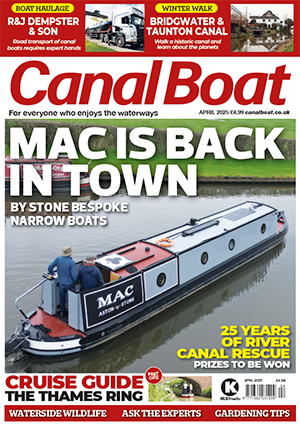 As featured in the April 2025 issue of Canal Boat. Buy the issue here
As featured in the April 2025 issue of Canal Boat. Buy the issue here

